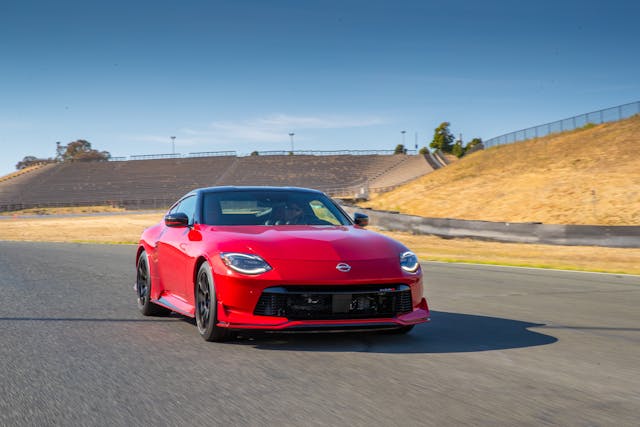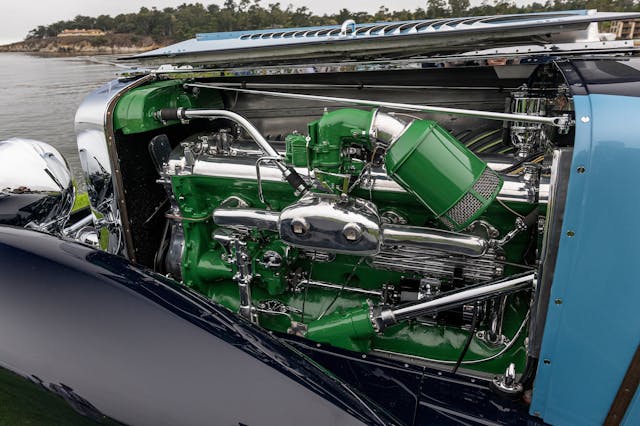Our Two Cents: The Goldilocks Horsepower Number
As you may recall, Goldilocks is the story of a woman eating from three bowls of porridge. Said bowls were at various temperatures, but only one was right for her. The same can be true for horsepower figures, as the Lucid Air Sapphire has a scalding 1234 hp. The Mitsubishi Mirage only has 78 hp, which is certainly too cold in our modern automotive climate. So what’s the Goldilocks horsepower number?


That’s the question we posed to the staff here at Hagerty Media, and our answers are just as diverse as our tastes in cars. So have a look at our thoughts, because what’s “just right” for one staffer might not work for others.
400 horses

400: This is pretty easy to get out of most modern engine designs while still having a durable, dependable, and serviceable powerplant. It’s also usually enough to spin the tires when you want to while still returning decent fuel economy. — Kyle Smith
650 horses?

550–650 hp in most applications (modern performance, big SUV, etc.) is about right for day-to-day. Goldilocks, however, is 700–900 hp via a nicely built RY45. — Matt Tuccillo
A “Weighty” Question

You can’t say for sure without knowing the weight. The sweet spot for me is 300 hp, but only saddled to 2600 pounds. Also, peak power doesn’t mean much to me either because if all the power is over 5000 rpm and the engine is asleep at 4000 (where I mostly drive) then I don’t care what those figures are. Okay, more than you wanted to know. — Larry Webster
This is Irrelevant!

Horsepower is meaningless in the age of electrification. The only numbers that matter anymore are range, consumption, and torque. In older cars, horsepower figures are either deliberately inflated (pre-SAE) and/or irrelevant. Does anyone care what the horsepower figure is for a Porsche 912? A Ferrari 250 GTO? A 260 Mustang vs a 289? It’s rare that anyone ever asks me the horsepower of my old cars and for most of them (’36 Riley, ’49 Buick, ’67 Porsche 912, ’73 Land Rover) I couldn’t even tell you, but it doesn’t diminish my interest in them. Goldilocks horsepower? As the man said, I know it when I see it. — Aaron Robinson
Less than 400


I’ll go out on a limb and say that anything much more than 400 horsepower is really just a unit of … well, member measurement for the average skilled driver in an AWD or RWD platform. Make it FWD and I’d go as low as 250–300 horsepower. Straight-line speed is fun, but moderate power where you can plant your foot and not get in too much trouble (either from lack of skill or that by way of that cop you didn’t notice) is my preferred state. — Greg Ingold
36 Horsepower

The answer is 36 hp—in my 370 lb go-kart, anyway. Any less and it wouldn’t scare me, and any more would probably make it illegal in my class. — Eddy Eckart
2400 horsepower!

Sorry y’all, but I gotta get all Texas up in here. Texas mile and TX2K to be precise, and we will take the biggest figure the aftermarket provides. I’ve driven a couple of 1000+hp, pump gas Lambos and they provide tame performance in traffic, while also offering mind-altering thrust in places like Mexico.
But it’s been a minute, and the number of turbocharged Lambos with 1500+ horsepower to the wheels suggests that might be about right for my needs. But 2400 horsies at all four wheels sounds delightful, as my foot knows how to treat a throttle pedal like a rheostat and not an on/off switch. Texas Tea also comes in race formulations, dont’cha know? — Sajeev Mehta
***
Check out the Hagerty Media homepage so you don’t miss a single story, or better yet, bookmark it. To get our best stories delivered right to your inbox, subscribe to our newsletters.



Everyone seems to have a good handle on the idea that “It depends”. I’ll say this, the most fun I’ve had is building cars that are much faster than anyone expects. My 225 wheel hp Miata in not very FAST but it’s hilariously quick and when someone dismisses it on the street or track, by the time they figure out what’s up, you’ve earned a thumbs up even if their car is much faster. I also truly loved an ’86 BMW 635 that I turbo’d to a titch over 500 whp, looked mighty stock on the outside, bit of a hammer on the street and track. Earning compliments from your peers for a well executed build is the second most satisfying aspect of high performance cars regardless of hp number.
Maybe the funnest car I have has 22 HP. (1915 Model T speedster) Surely not because of its blazing acceleration or top speed!
110 hp is nice if it’s in a Formula Ford.
In the northeast I would say 400hp is just about right. 650hp may stick to hot Georgia pavement but up here it’s a good way to end up in the woods.
HP to weight! I have two “sports” cars. One has 155HP and the other has 265HP. Which one is more fun to drive, the one with 155HP, it weighs 1,000lbs, the one with 265HP weighs 2,900lbs. 6.5lbs per HP verses 10.9lbs per HP. Colin Chapman said it best; “Add lightness”. The sweet spot for HP means nothing unless the rest of the vehicle is taken into account. We all know Goldilocks took the middle bowl but does anyone consider it might have held the right amount of porridge.
Now that traction control exists, and works, the old expression “no such as too much power” is probably the answer to the question.
For me the number of variables to traction make picking a number difficult, so I’ll go with enough that I can scare myself back to reality when required.
*taps Aaron on the shoulder* – the “age of electrification” is disintegrating before our eyes. EVs have no resale value, explode/ignite at inconvenient times, have range issues still, arguably ho little net effect on emissions (powered from the grid which still uses coal/diesel/nat gas). On top of that they’re very fragile – they get totaled by water (pick any storm/hurricane), and won’t work when it gets too cold. Dealers are turning away manufacturers because their lots are filled with unsold vehicles. ICEs will remain the power source – and hybrids will be a part of that going forward.
I could do things with my ’68 911L that physics said I couldn’t & that was only around 140 horsepower as I remember. Horsepower is a lot like love making. It’s not the length of your pencil but how you sign your name!
“The Mitsubishi Mirage only has 78 hp, which is certainly too cold ” That’s still way more than the 57 hp from my ’70 VW Karmann Ghia convertible, (at least that’s what VW claimed 54 years ago, I’m not sure it’s still using all 57 of them) but it’s still a lot of fun to drive when the sun comes out.
As I said, 400 is my magic number.
However your number is whatever makes YOU happy!
For the street, enough to merge into traffic and pass when needed. The lighter the vehicle, the less needed to make the car enjoyable to drive. Too much just isn’t usable and tends to get one in trouble.
At the track, as much as you can get to hook up, and enough money to cover the surprises.
With a driver aboard plus 3 or 4 gallons of gas, Eddie Eckart’s Kart produces about the same power to weight ratio as a similarly laden NC3 or NC4 Miata, which, equipped with a stiffer set of anti-roll bars handles better than my early Formula Ford. But on a road trip you can’t beat something that blends in, like my dark gray 2007 4Runner Sport. It can’t be tossed around like the Miata, but will sweep through curves with a surprising turn of speed for a vehicle its size. It also has a spare wheel, which is nice:-)
I’ve owned a 1966 GTO with 335HP and today I own a 2005 E46 M3 with 333HP and they were both enjoyable to drive enthusiastically. However, the technology in suspension and brakes in 1966 was sorely mismatch for the horsepower.
I have 472hp on my daily driver. It is enough… for now.
My “sports car” probably has a few less (430hp-ish) but I still love it, 22 years and counting.
Larry Webster stated the most knowledgeable answer.
I also learned — except for track use, really fast cars are useless for daily driving. As a wise person once said “It’s more fun trying to go fast in a slow car, than having to drive slow in fast car to stay out of trouble”.